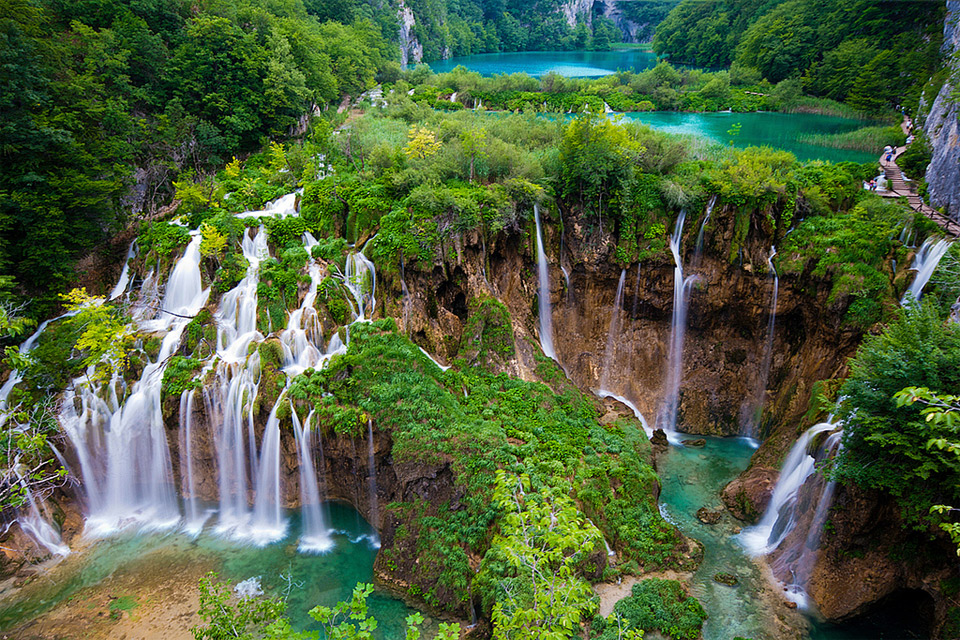Visit the Plitvice Lakes Natural Park in Croatia

The most beautiful natural landscape in the interior of Croatia, the Plitvice Lakes National Park (in Croatian: Nacionalni Park Plitvička jezera), is well worth a visit during our stay in Dubrovnik.
It is not a nearby excursion, since it is more than 400 kilometers away, but the wonder that awaits us there will compensate for the effort of the trip. As it is, as it happens in the Blue Lake in Iceland, a fascinating place due to its spa of thermal waters that without a doubt you cannot miss when traveling to Iceland.
Plitvice, which has been part of the UNESCO World Heritage since 1979, has an area of 30,000 hectares of forests, mainly leafy beech forests, although there are also fir trees and pine trees.
This forest mass is home to numerous animal species, including lynx, deer and various amphibian species that inhabit Plitvice lakes and streams.
A paradise of lakes and waterfalls.
The absolute protagonist of Plitvice Park is, however, water, which has modeled the landscape of these lands over millennia.
Hidden in the thicket are hidden 16 lakes of different sizes fed by the Korana River and communicated with each other by a dense network of waterfalls, canals, and waterfalls.
Plitvice lakes line up forming a long succession of just over five and a half kilometers.
Ordered from north to south, they are as follows:
Prošćansko: The second largest Plitvice lake.
Ciginovac
Okrugljak
Batinovac
Veliko
Bad
Vir
Galovac
Milino
Gradinsko
Veliki Burget
Kozjak: The largest and deepest, with 47 meters.
Milanovac
Gavanovac: Where the spectacular Milka Ternina waterfall is located, with 47 meters of fall.
Kaluđerovac: Where are the caves of Golubnjača and Šupljara.
Novakovića Brod.
Caves
The entire area of the park is encompassed within the karst area of southeastern Europe, whose main feature is the abundance of fragile and porous rocks, especially limestones, which gives rise to all kinds of caves, chasms, cracks and underground cavities.
The cave system is so complex that it has not yet been fully explored by speleologists. Even so, visitors to the park can go into some of them such as Golubnjača and Šupljara, on the banks of Lake Kaluđerovac, as well as those of Čudinka and Rodic, where remains of the gigantic Cave Bear have been found, an extinct species about 10,000 years
¿How to get from Dubrovnik?
To get to Plitvice from Dubrovnik it is essential to have a vehicle, so the best option is to rent a car. A trip of four and a half hours awaits us, so it is advisable to make several stops along the way.
It is advisable to get up early and go first thing in the morning, as it is a very visited place, and the parking lot fills up quickly, when you arrive later, you park further. The entrance time in the Park from April is from 07.00 to 20.00, extending the closing time of the parking one more hour.
If you have not decided to rent a car but want to see the Plitvice Lakes, you can also arrive by bus, which depart from the main cities of the country: Zagreb, Split, Zadar.
Practical information to visit the park
The price of the entrance to the Plitivice Lakes National Park depends on what time of the year you go. In low season (from November to March, both inclusive) the price is 55 Kunas, in exchange they are just over 7 euros per person.
In mid season (April, May, June and September) the price is 150 Kunas per person, € 20.30, and high season (July and August) 250 Kunas, € 33.85 if you enter before 4 in the afternoon, after 4 in the afternoon the entrance fee is 150 Kunas, € 20.30.
The price includes the boat ride on the largest lake, and the journey in a kind of tourist train that brings you closer, both to go and to return, from the car parks to the park entrance.
The frequency of these two internal means of transport is approximately every half hour, and they only work in summer, from April to September.
Due to its popularity, on weekends and during the summer months many people go to the Plitvice Lakes, to enjoy a unique landscape in the world and to bathe in its blue waters.
However, visiting the park in winter is not a bad idea, especially if you are lucky enough to find the indescribable spectacle of frozen falls.



